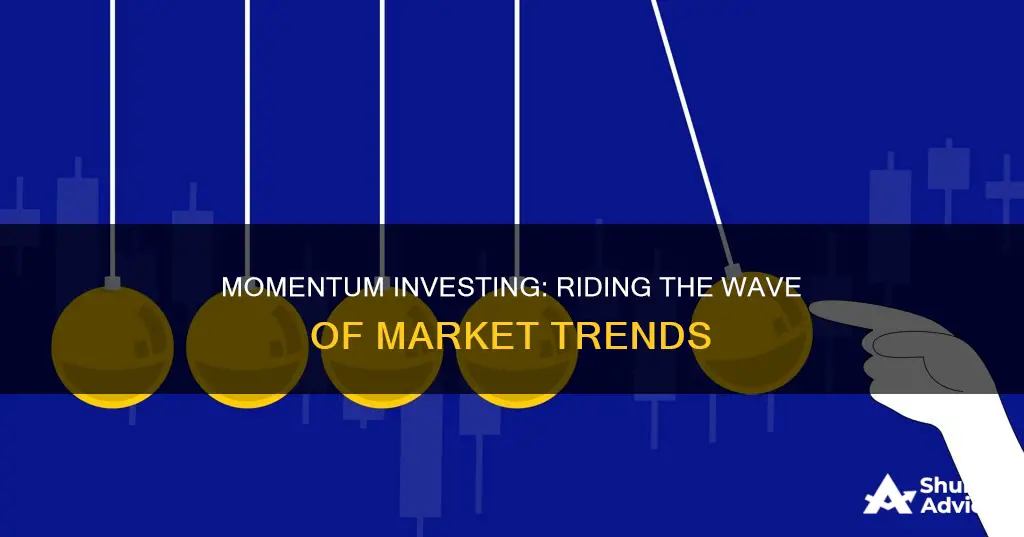
Momentum investing is a trading strategy that involves buying securities that are already rising and selling them when they appear to have peaked. This approach leverages market volatility to generate short-term profits. It contradicts the traditional buy low, sell high adage, instead advocating buying high and selling higher. The core principle of momentum investing is that once a trend is established, it is likely to continue. This strategy is based on technical analysis, utilising tools like trend lines, moving averages, and momentum oscillators to identify and exploit market trends. While momentum investing has been shown to produce above-average returns, it is also associated with higher risks, transaction costs, and the challenge of precise market timing.
| Characteristics | Values |
|---|---|
| Definition | A strategy that aims to capitalise on the continuance of an existing market trend. |
| Buying and selling | Buying securities that are already rising and selling them when they have peaked. |
| Market trends | Market trends are more likely to continue than reverse. |
| Risk | High risk due to reliance on the continuation of trends. |
| Returns | Potential for high returns over a short period. |
| Timeframe | Typically a short-term strategy. |
| Volatility | Leveraging market volatility to one's advantage. |
| Investor behaviour | Exploiting the behavioural weaknesses of other investors, such as herd mentality. |
| Technical analysis | Using technical indicators to identify trends and gauge their strength. |
| Fundamental analysis | Not concerned with a company's operational performance. |
What You'll Learn

Buying high and selling higher
The concept of buying high and selling higher is based on the idea that market trends are likely to continue in their current direction. While trends do eventually reverse, statistical analysis suggests that this happens less frequently than a continuation of the existing trend. Therefore, by buying stocks that have been performing well, investors aim to profit from the continuation of the upward trend.
Richard Driehaus, often considered the father of momentum investing, advocated for this approach. He believed that "far more money is made buying high and selling at even higher prices". Driehaus focused on identifying stocks with accelerating earnings growth, increasing volume, and rising prices.
Momentum investing requires careful timing and a strict set of rules. Investors use technical indicators, such as trend lines, moving averages, and momentum oscillators, to identify entry and exit points. It is crucial to enter a position early in the trend and exit before any signs of weakness or reversal.
While momentum investing can lead to high profits over a short period, it also carries significant risks. It relies on the continuation of trends, and a reversal can result in substantial losses. Additionally, the frequent buying and selling involved in momentum investing can lead to higher transaction costs and increased fees.
Depreciation's Impact on Cash Flow: Investing Activities
You may want to see also

Identifying market trends
Momentum investing is a strategy that aims to capitalise on the continuation of an existing market trend. It involves buying securities that are already rising and selling them when they appear to have peaked.
Momentum, in this context, refers to the rate of acceleration of a security's price or the speed at which the price is changing. It indicates the capacity for a price trend to sustain itself going forward.
- Moving Average Convergence Divergence (MACD): This is a popular technical indicator that depicts the relationship between two moving averages of a security's price. It is calculated by subtracting the 26-period exponential moving average from the 12-period moving average. A MACD line is created, and a nine-period MACD line, known as the "signal line", is transposed over the MACD line. This functions as a trigger to buy or sell, depending on where the MACD crosses the signal line.
- Stochastic Oscillator: This indicator measures the closing price of a security relative to a range of its historical prices over a defined period. It generates overbought and oversold trading signals using a 0-100 bounded range of values. Values above 80 are considered overbought, while those below 20 are considered oversold, indicating a potential reversal in the trend.
- Relative Strength Index (RSI): The RSI measures the magnitude of recent price changes, typically looking at average gains or losses over 14 trading periods. It uses a bounded range of 0 to 100 to indicate overbought or oversold conditions in the price of an asset. Values above 70 indicate an overbought security, while values below 30 indicate an oversold condition.
- Price Rate of Change (ROC): The ROC measures the speed at which a variable changes over a specific period and is expressed as a ratio between the change in one variable relative to another. A security with a high momentum has a positive ROC and tends to outperform the market in the short term.
- Volume-Weighted Average Price (VWAP): The VWAP allows traders to monitor how a price is trending in relation to its volume. Significant increases or decreases in the VWAP can be strong bullish or bearish signals, respectively.
These tools can help identify market trends and inform buying and selling decisions in a momentum investing strategy. However, it is important to note that momentum investing carries risks, including high transaction costs, market timing challenges, and the potential for substantial losses if the momentum reverses.
Cash App Investing: A Guide to Getting Started
You may want to see also

Technical analysis
Momentum investing is a trading strategy that aims to capitalise on the continuation of an existing market trend. It is a purely technical trading strategy, meaning that momentum investors are not concerned with a company's operational performance, but rather the analysis of a security to identify trends and gauge the strength of the trend.
Momentum investors use technical indicators to inform their trades. These indicators are used to determine the strength or weakness of a stock's price trend. Common indicators include the relative strength index (RSI), moving average convergence divergence (MACD), stochastic oscillators, and the price rate of change (ROC).
The RSI was created by J. Welles Wilder Jr. in the 1970s and is used to determine if a stock is oversold or overbought. It assigns stocks a value between 0 and 100, which can then be compared to thresholds. The RSI is best used in conjunction with other indicators to strengthen its conclusions.
The MACD depicts the relationship between two moving averages of a security's price and is calculated by subtracting the 26-period exponential moving average from the 12-period moving average. The MACD line is then used as a trigger to buy or sell, depending on where it crosses the "signal line".
The stochastic oscillator compares an asset's most recent closing price to its prices over a specified period. It generates overbought and oversold trading signals using a 0-100 bounded range of values. Values over 80 are considered overbought, while values below 20 are considered oversold.
The price rate of change (ROC) is the speed at which a variable changes over a specific period. It is expressed as a ratio between the change in one variable relative to a corresponding change in another. A security with a high momentum has a positive ROC and is likely to outperform the market in the short term.
Momentum investors also seek to analyse, understand, and anticipate the behaviour of other investors in the market. Awareness of behavioural biases and investor emotions can significantly enhance the effectiveness of a momentum investing strategy.
VRDN Investment: Is It Worth the Risk?
You may want to see also

Risk and reward
Momentum investing is a strategy that aims to capitalise on existing market trends. It involves buying securities that are already rising and selling them when they appear to have peaked. This strategy is based on the assumption that market trends are more likely to continue than reverse.
Momentum investing can be a risky strategy. It relies on the continuation of trends, and if the momentum reverses, it can result in substantial losses, especially if the investor holds their position for too long. This strategy is also more sensitive to market volatility, and sudden price swings can disrupt trends and lead to unpredictable outcomes.
Momentum investing is also associated with higher transaction costs due to the frequent buying and selling of securities. These costs can eat into profits, especially in markets with high trading fees or bid-ask spreads.
However, momentum investing also offers the potential for high profits over a short period. By identifying and riding market trends, investors can achieve significant gains. The strategy also has a shorter investment horizon, allowing investors to capitalise on quick market movements.
Another benefit of momentum investing is that it is less dependent on fundamentals. Instead of focusing on a company's operational performance, investors can profit from market psychology and sentiment, even if the stock's intrinsic value is uncertain.
Overall, momentum investing offers the potential for high returns but also carries significant risks. It requires sophisticated risk management and a disciplined approach to buying and selling at the right times.
Oakmark's Cash Strategy: Liquidated Investments and Holdings
You may want to see also

Investor psychology
Momentum investing is a strategy that aims to capitalise on the continuation of an existing market trend. It involves buying securities that are already rising and selling them when they appear to have peaked. This strategy is based on the belief that trends can persist for some time and that it is possible to profit by staying with a trend until its conclusion.
Momentum investors seek to take advantage of investor psychology and herd behaviour by leading the pack in and being the first to take profits. They buy into rising stocks, anticipating that the upward momentum will continue, and sell declining stocks, expecting the downward trend to persist. This approach is driven by the fear of missing out (FOMO) and the belief that investor sentiment can magnify trends. As a stock price climbs, more investors may join in, further pushing up the price.
Momentum investing is influenced by the premise that short-term trends tend to continue. Therefore, investors expect a stock that has been rising to keep rising and a stock that has been declining to keep declining. This strategy involves frequent buying and selling, which can increase portfolio volatility. It requires a thorough understanding of its risks and its role within a comprehensive portfolio strategy.
Momentum investors often utilise technical indicators, such as charts and mathematical formulas, to analyse past price movements and predict future trends. They may also use moving averages and the relative strength index (RSI) to identify trends and potential entry or exit points.
While momentum investing can offer potential rewards, it also carries risks. There is no guarantee that past top performers will maintain their momentum, and sudden corrections or unexpected news can lead to unforeseen losses. Momentum strategies are prone to herd mentality, where investors follow the crowd without considering the underlying value, potentially resulting in asset bubbles and sudden corrections.
Securities Trading: Part of Investing Cash Flow?
You may want to see also
Frequently asked questions
Momentum in investing refers to the capacity for a price trend to sustain itself going forward. It is the belief that market trends are likely to continue in their current direction.
Momentum investing involves buying securities that are already rising and selling them when they appear to have peaked. It is a short-term strategy that aims to capitalise on volatile market trends.
Momentum investing can lead to large profits over a short period. It also allows investors to leverage market volatility and sentiment to their advantage.
Momentum investing offers the potential for high returns over a short period, shorter investment horizons, and reduced dependence on fundamentals. It can also be applied across various asset classes, providing diversification potential.
Momentum investing is inherently risky, with a high potential for substantial losses if the trend reverses. It also presents market timing challenges, increased volatility sensitivity, and higher transaction costs.







